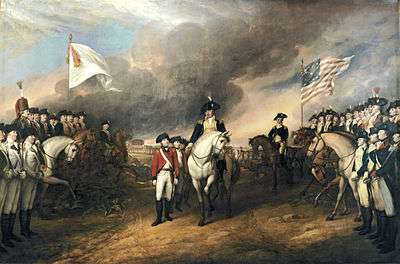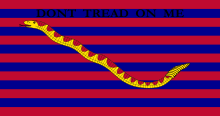South Carolina Navy
 |
| Armed Forces |
| United States |
|---|
| Great Britain |
| France |
| Related topics |

A South Carolina Navy has been formed twice by the State of South Carolina. The first time was during the American Revolutionary War, in which the state purchased and outfitted armed vessels independent of the Continental Navy. The second time was during the American Civil War, when its navy was also distinct from the Confederate States Navy.
American Revolutionary War
South Carolina's first naval actions of the American Revolutionary War occurred in July 1775, when the province's Council of Safety hired two captains to assist Georgia in the capture of British ships carrying arms and gunpowder.[1] That month the council also hired a ship, the Commerce, for the purpose of acquiring gunpowder that the British had stored at Nassau in the Bahamas. She was outfitted for this purpose, but word of the anticipated arrival of British ships carrying arms and gunpowder at Savannah, Georgia prompted her to be used to capture those ships instead. These activities netted the colonial cause more than 25,000 pounds of gunpowder.[2] In October 1775, the council acquired the schooner Defence, and hired Simon Tufts as her captain. After she had a brief exchange with British ships in Charleston harbor in November, the provincial congress voted to seize the Prosper to assist in driving the British ships away, and established a commission to oversee naval affairs.[3]
In December, a third ship, the Comet, was added to the fleet, and the council sent Robert Cochran to recruit experienced seamen in Massachusetts. As Boston was at the time under siege by George Washington's newly formed Continental Army, Massachusetts authorized him to recruit up to 300 men, provided he offered moderate wages so as to not compete with local needs.
The provincial congress in early 1776 authorized committees in other provincial ports to acquire ships and men for local defense, and fixed pay scales and ranks for state land and naval forces. In March 1776 the schooner Peggy entered the state service. In the following months the congress, now operating under a new constitution, passed laws establishing admiralty courts and providing for the appointment of ship captains. Captains were to be chosen by the legislature, with commissions issued by the state president. On October 8 the legislature established a Board of Naval Commissioners to oversee the state's naval affairs, including the purchase, outfitting, and manning of ships, and the management of its shipyards. This organizational structure survived until February 1780, when the state legislature repealed all previously-established laws respecting the naval establishment.
Throughout 1777 and 1778 the state acquired property for shipyards, and brought more ships into service. This included the Paul Pritchard Shipyard at Mount Pleasant, South Carolina.[4] This activity picked up pace when the British captured Savannah late in 1778, bringing the war closer to the state. When it became clear the British were going to make a second attempt on Charleston in 1780, the state procured additional ships, and the naval defense of Charleston was passed to Continental Navy captain Abraham Whipple. Most of the state's ships were lost during the Siege of Charleston, and only a few small ships were commissioned after the tide of battle turned against the British in 1781. One ship that survived the loss of Charleston was the frigate South Carolina, which was at sea at the time.
Commodore Alexander Gillon had procured the South Carolina in Europe, which the state had ordered in March 1778.[5] Previously named Indien, she was chartered from the Chevalier de Luxembourg for a three-year period. The charter agreement provided that prize money was to be divided between the officers and crew (½), South Carolina (¼), and the Chevalier Luxembourg (¼). On her way from Europe to South Carolina she captured several prizes, and she participated in the 1782 capturing of the Bahamas with the Spanish fleet. She was captured in December 1782, and the financial terms Gillon agreed to concerning prize distribution and indemnification of the Chevalier de Luxembourg for its loss bedeviled the state's finances for years.
Additionally, the Navy included frigates, Rattlesnake, Bricole, and Truite, 26, the brigs Notre Dame, 16, and Comet; also General Moultrie, 20. Bricole, Truite, Notre Dame and General Moultrie all participated in the defense of Charleston in early 1780.
Bricole was a flûte built by Jean-Joseph Ginoux and launched around April 19, 1764. In September 1779 she sank in the Savannah River but was refloated. The next month the French ceded her to the South Carolina government. The South Carolinians wanted to convert her to a frigate of 44 guns, but then gave up the idea and made her a floating battery instead. As such she was armed with fourteen 12-pounder guns on her lower deck and twenty-two 8-pounder guns on her upper deck. In March 1780 she was sunk in front of Charleston, South Carolina to impede the entry of British naval vessels.[6]
Truite was a French vessel built to plans by Jean-Joseph Ginoux and built and launched at Le Havre on May 9, 1777. The French transferred her to the South Carolina Navy in December 1779. By March 1780 she was a frigate of 26 guns. She was sunk in the Copper River to prevent a British squadron from sailing up the river.[7]
American Civil War
Ships included Lady Davis, which later served in the Confederate States Navy as CSS Lady Davis.
South Carolina Naval Militia
After the American Civil War, states maintained both army and naval militias. During the Spanish–American War, the South Carolina Naval Militia was federalized and deployed aboard several United States Navy vessels.[8] In 2003, the state of South Carolina reactivated the naval militia under the South Carolina Maritime Security Act.[9]
Notes
- ↑ Paullin, p. 418
- ↑ Paullin, pp. 418-419
- ↑ Paullin, p. 420
- ↑ "Paul Pritchard Shipyard, Charleston County (Address Restricted)". National Register Properties in South Carolina. South Carolina Department of Archives and History. Retrieved 2014-08-01.
- ↑ Paullin, p. 435
- ↑ Demerliac (1996), p.34, #154.
- ↑ Demerliac (1996), p. 107, #749.
- ↑ Pinckney, P. H.; Robison II, Kenneth H. "A Brief History of the South Carolina Naval Militia". The Spanish American War Centennial Website. Retrieved 5 November 2014.
- ↑ "South Carolina Maritime Security Act". South Carolina Legislature Official Website. Retrieved 5 November 2014.
References
- Coker, P. C., III.(1987) Charleston's Maritime Heritage, 1670-1865: An Illustrated History. (Charleston, S.C.: Coker-Craft).
- Demerliac, Alain (1996) La Marine De Louis XVI: Nomenclature Des Navires Français De 1774 À 1792. (Nice: Éditions OMEGA). ISBN 2-906381-23-3
- Paullin, Charles Oscar (1906). The navy of the American Revolution: its administration, its policy and its achievements. The Burrows Brothers Co. This work contains summary information on each of the various state navies.